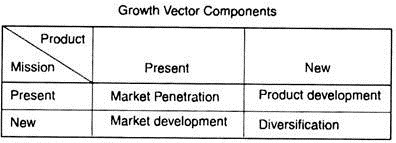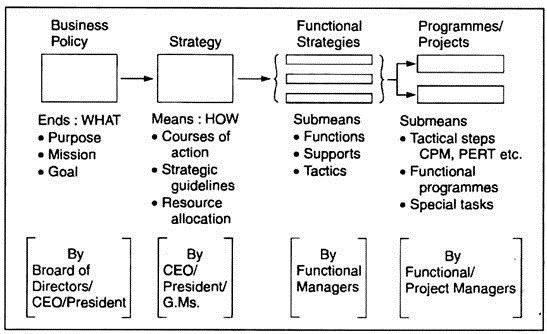In this article we will discuss about the nature and scope of corporate strategy of a firm.
Corporate strategy is a management concept. Ansoff, by means a matrix: growth vector components (illustrated below), indicates the direction in which the firm should move with respect to its current product-market posture.
‘Market penetration’ denotes a growth direction through the increase of market share for the present product-markets. In ‘market development’ new missions are sought for the firm’s products. ‘Product development’ creates new products to replace current ones Finally, ‘diversification is distinctive in the fact that both products and missions are new to the firm (Ansoff).
ADVERTISEMENTS:
Ansoff goes on to state that either ‘marketing skills’ or ‘product technology’ or both provide the common thread or specification for all components except for ‘diversification’.
For this, he introduces the element of ‘Synergy’ as profitability potential necessary for success in the new ventures i.e., diversification. According to him, all the four characteristics are complementary, rather than mutually exclusive. In conjunction with its objectives the firm may choose one, two, or all of the strategic components.
For example, a firm may specify the following:
Thus strategy and objectives together ‘specify the amount of growth, the area of growth, the directions for growth, the leading strengths, and the profitability target’.
ADVERTISEMENTS:
Fred Busy suggests four components of a corporate strategy as:
(1) Market opportunity,
(2) Corporate competence and resources,
ADVERTISEMENTS:
(3) Personal values and aspirations of top executive, and
(4) Acknowledged obligations to segments of society other than the stakeholders.
These components, thus, imply that corporate strategy is concerned with optimising the firm’s relationship with the environment.
Chang and Campo-Flores, while explaining the nature and scope of corporate strategy, introduced a Model (illustrated below):
The Model highlights that:
(1) Corporate policy constitutes the ‘end’, and
(2) Strategy sets forth the ‘means’ to achieve the ‘end’.
The second factor spells out the detailed courses of action and resource allocation processes.


